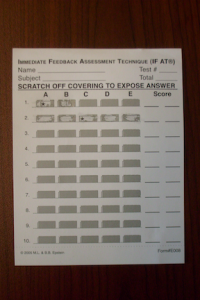
Last month I attended the annual Society for Teaching and Learning in Higher Education (STLHE) 2014 Conference that was held in Queens University, Kingston. It was an excellent opportunity for me to learn from colleagues across Canada and exchange ideas with them. One of the workshops that attracted my attention was facilitated by Aaron Slepkov and Ralph Shiell from the Dept. of Physics at Trent University. In their workshop, Ralph and Aaron focused on their newly developed testing technique: “Integrated Testlet (IT)”. The presenters started by talking about the benefits of Constructed Response (CR) questions, a common term for questions where students must compose the answer themselves, and how these types of questions enable instructors to gauge their students’ learning. CR questions also allow instructors to give part marks to partially correct answers. The presenters also commented on the trend to switch from CR questions to Multiple Choice (MC) questions in the field of Physics due to increasing class size and the resulting contraints on time and personel resources. However, traditional MC questions don’t allow for part marks or, more importantly from a pedagogical standpoint, enable the instructors (and students) to know where the students went wrong. The integrated testlet method is different in that not only does it allow the students to keep trying each MC question until they get the correct answer, “answer-until-correct question format” enabling the granting of partial marks, but student do not leave the question without knowing the correct answer enabling them to move on to the next integrated question. The method presented changed complex CR physics questions into IT questions. The IT method is based on a traditional testlet, which is a group of MC questions that are based on a common stem (or scenario). In an IT, an answer to a question (task) leads to the next task procedurally, and in this way the students’ knowledge of how various concepts are connected can be assessed. Therefore, items in an integrated testlet are presented in a particular sequence in which the answer for part (a) is used to solve for part (b) and so on. The IT rely on the use of an “answer-until-correct response format”, where the students can keep on making selections on a MC question until the correct response is identified and can be used in subsequent related items. The presenters used the Immediate Feedback Assessment Technique (IF-AT) to allow the students to do several attempts and to get part marks for their response. For more information about IF-AT cards, see Epstein Educational Enterprises website. Moreover, for a sample application of the IF-AT cards at the University of Waterloo see the CTE blog by my colleague Mary Power, The faculty of Science Liaison. In their published paper, the presenters explain the method they have used to transform CR questions to IT questions and analyzed the students’ responses for both question types; it is a very useful and interesting reading that I recommend for instructors thinking about this method.

